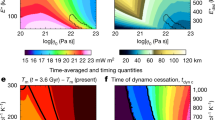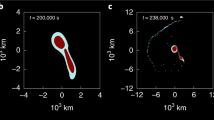Abstract
THE geometrical ellipticity of Mars differs considerably from the dynamical ellipticity obtained from the precession of the orbits of the satellites. Study1 of the Martian centre of mass lead Schubert and Lingenfelter to comment that the location of the Hellas basin near the direction of the thinnest crust, as implied by the offset, might suggest that an impact produced the asymmetric crustal distribution. If such an impact did occur then it is likely to have also affected the shape of Mars. An order of magnitude estimate can therefore be made, from the shape of Mars, of the required size and velocity of the impacting body.
This is a preview of subscription content, access via your institution
Access options
Subscribe to this journal
Receive 51 print issues and online access
$199.00 per year
only $3.90 per issue
Buy this article
- Purchase on Springer Link
- Instant access to full article PDF
Prices may be subject to local taxes which are calculated during checkout
Similar content being viewed by others
References
Schubert, G., and Lingenfelter, R. E., Nature, 242, 251 (1973).
Dollfus, A., Icarus, 17, 525 (1972).
Sinclair, A. J., Mon. Not. R. astr. Soc., 155, 249, 1972.
Runcorn, S. K., Icarus, 18, 109 (1973).
Author information
Authors and Affiliations
Rights and permissions
About this article
Cite this article
PETERSONS, H. Shape of Mars. Nature 253, 103–104 (1975). https://doi.org/10.1038/253103a0
Received:
Revised:
Issue Date:
DOI: https://doi.org/10.1038/253103a0
Comments
By submitting a comment you agree to abide by our Terms and Community Guidelines. If you find something abusive or that does not comply with our terms or guidelines please flag it as inappropriate.



